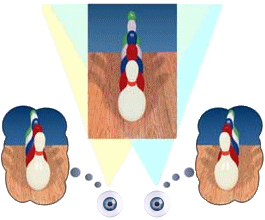3D Television
Current 3D Televisions use LCD Shutter Technology although some may offer Dolby 3D in the future. Read our 3D Theater Technology page for more information about the different types of 3D technology. This page will specifically focus on 3D LCD Shutter technology.
How 3D TV it works
All 3D technology works by displaying different images to the viewer's left and right eye. This can be accomplished by colored filters, polarizing filters, or LCD shutters. In a home system, this is typically done using LCD Shutter Glasses. A 3D capable LCD Television displays 120 frames each second, 60 frames for each eye. In the first frame, the TV displays an image for the left eye and the glasses block the right eye from seeing the TV. In the next frame, the TV displays an image for the right eye and the glasses block the left eye. This happens 60 times a second. It is so fast that the brain don't pick up on the fact that half the time the LCD Shutter Glasses are active and completely blocking the eye from seeing the television. The brain fills in the missing pieces to create a continuous picture.
How to get 3D TV
The first thing you need for 3D at home is a 3D capable television. This is usually a 120Hz TV. There are 240Hz televisions that can display 240 frames per second on the screen and the glasses shutter at 120 times a second. Some people may find that the lower blink rate of the 60Hz glasses cause headaches and might prefer the faster models. Be sure to check out any TVs at the store before making a purchase.You will also need 3D LCD Shutter glasses that are designed to go with your TV. Your TV might come with a pair of glasses, but you will need one set per viewer so you may need to purchase extra. These glasses automatically wirelessly synchronize with the TV so that the left and right lenses blink at the correct times. Some glasses use bluetooth for this synchronization, and others use infrared or some other wireless technology. Be sure to get the correct ones for your TV.
You can get TVs that actually take a 2D show and convert it automatically to 3D. This method can never be perfect, but it you are spending a lot of money on a 3D system it might be nice to know you can watch anything in 3D.
Note: Some TVs and other devices are listed as 3D ready. I would be wary of TVs making this claim. It implies that some device will exist in the future that will make the TV 3D capable. Some TVs that are 120 Hz make this claim simply because they show enough frames per second. It does not mean that they are capable of sync'ing with LCD Shutter Glasses or that the response times of the TV are truly capable of displaying a 3D image.
3D Data Sources
You can get 3D from your Satellite/Cable provider, Blu-Ray player, a Video Game system, and a Computer. For satellite and cable, there might be a surcharge for a 3D capable satellite or cable box. Make sure they carry enough channels to make this worth it worth the extra cost. For Blu-Ray systems, both the player and the Blu-Ray disc must be labeled 3D. For Video Game systems, both the game system and the game must be labeled 3D. For computers, read our section on Media Center PCsIn all cases, the system must be listed as 3D capable and you must use the correct type of cable to connect component to your TV. This will usually be a Version 1.3 HDMI cable (aka High Speed HDMI), although DisplayPort will also be an option. Look online for cables. You don't need to spend more than $10 for a good HDMI cable unless you need a really long one. If you are running your HDMI cables through a home theater receiver, you should look at getting one with HDMI 3D pass-through technology